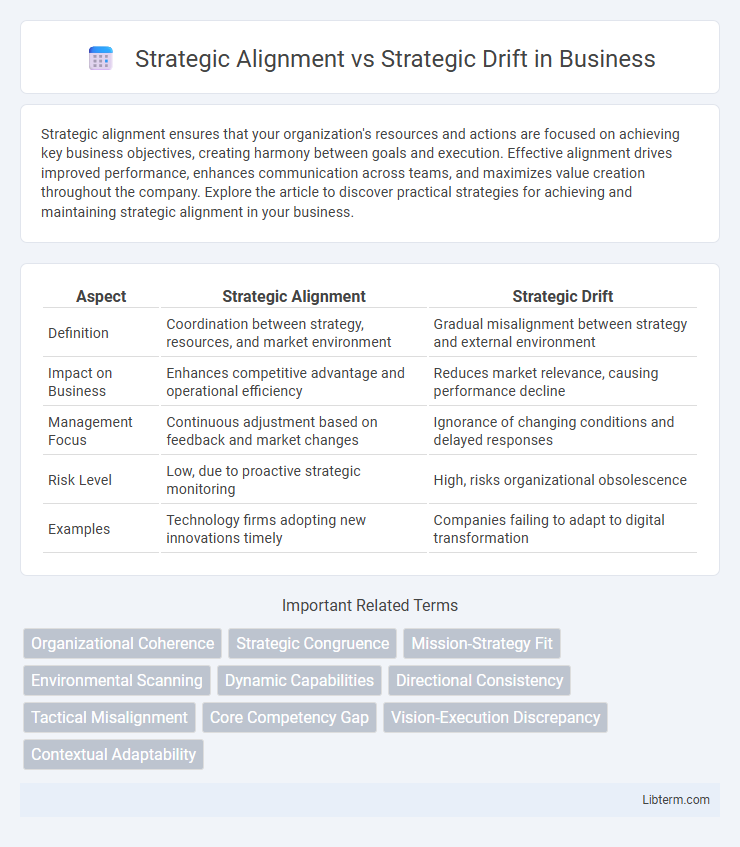Strategic alignment ensures that your organization's resources and actions are focused on achieving key business objectives, creating harmony between goals and execution. Effective alignment drives improved performance, enhances communication across teams, and maximizes value creation throughout the company. Explore the article to discover practical strategies for achieving and maintaining strategic alignment in your business.
Table of Comparison
| Aspect | Strategic Alignment | Strategic Drift |
|---|---|---|
| Definition | Coordination between strategy, resources, and market environment | Gradual misalignment between strategy and external environment |
| Impact on Business | Enhances competitive advantage and operational efficiency | Reduces market relevance, causing performance decline |
| Management Focus | Continuous adjustment based on feedback and market changes | Ignorance of changing conditions and delayed responses |
| Risk Level | Low, due to proactive strategic monitoring | High, risks organizational obsolescence |
| Examples | Technology firms adopting new innovations timely | Companies failing to adapt to digital transformation |
Understanding Strategic Alignment
Strategic alignment ensures that an organization's resources, capabilities, and activities are consistently directed toward achieving its long-term goals and vision. Effective strategic alignment requires continuous communication between leadership and operational teams to maintain coherence between strategy formulation and implementation. Misalignment or failure to adapt to external changes often results in strategic drift, where the organization's actions gradually diverge from its intended strategic path.
What is Strategic Drift?
Strategic drift occurs when an organization's strategy gradually becomes misaligned with the external environment and evolving market conditions, leading to decreased competitiveness and performance. This phenomenon often results from complacency, lack of environmental scanning, or rigid adherence to outdated strategic assumptions. Detecting early signs of strategic drift involves monitoring key performance indicators and regularly reassessing strategic goals against industry trends and competitor actions.
Key Differences: Strategic Alignment vs Strategic Drift
Strategic alignment ensures that an organization's resources, goals, and actions are consistently directed toward its long-term objectives, fostering coherence and competitive advantage. In contrast, strategic drift occurs when a company fails to adjust its strategy in response to environmental changes, leading to misalignment and performance decline. Key differences include proactive adaptation in strategic alignment versus inertia and lag in strategic drift, impacting organizational effectiveness and market positioning.
Causes of Strategic Drift in Organizations
Strategic drift occurs when an organization's strategy gradually becomes misaligned with its external environment due to slow response to market changes and emerging technologies. Causes include complacency, rigid corporate culture, poor communication, and failure to monitor competitive dynamics effectively. This results in outdated goals, lost market position, and diminished organizational performance.
The Importance of Strategic Alignment for Business Success
Strategic alignment ensures that a company's business goals, resources, and activities are cohesively directed toward achieving its core mission, thereby maximizing operational efficiency and competitive advantage. Failure to maintain strategic alignment often results in strategic drift, where misaligned objectives cause wasted resources and reduced market responsiveness, ultimately threatening business sustainability. Achieving and sustaining strategic alignment fosters clear communication, agile decision-making, and consistent execution, which are critical for long-term business success.
Signs Your Organization Is Experiencing Strategic Drift
Signs your organization is experiencing strategic drift include a growing disconnect between long-term goals and daily operations, declining competitive performance, and resistance to change from leadership or employees. Key indicators also involve inconsistent resource allocation that no longer supports core strategies and a misalignment between organizational capabilities and market demands. Monitoring these warning signs is crucial to realign strategy, maintain market relevance, and drive sustainable growth.
Strategies to Maintain Strategic Alignment
Effective strategies to maintain strategic alignment involve continuous environmental scanning, ensuring the organization adapts proactively to market changes and emerging trends. Implementing regular performance reviews aligned with core objectives enables early detection of deviations, minimizing the risks of strategic drift. Fostering cross-functional communication and leadership commitment reinforces cohesive execution, sustaining alignment between organizational goals and operational activities.
Case Studies: Alignment vs Drift in Real Businesses
Case studies highlight how companies like IBM achieved strategic alignment by continuously updating their business models to match technological advancements and market demands, resulting in sustained growth and competitive advantage. Conversely, firms such as Kodak experienced strategic drift by failing to adapt to digital photography trends, leading to market share loss and eventual decline. These examples underscore the critical importance of proactive strategy realignment to maintain organizational relevance and performance.
Overcoming Challenges in Achieving Strategic Alignment
Overcoming challenges in achieving strategic alignment requires continuous communication between all organizational levels and regular reassessment of goals to ensure they align with evolving external market conditions. Integrating adaptive leadership and fostering a culture of agility helps prevent strategic drift by addressing internal resistance and facilitating timely strategy adjustments. Employing performance metrics and real-time data analytics supports proactive decision-making, ensuring strategies remain aligned with organizational objectives and stakeholder expectations.
Future Trends: Adapting Strategy in a Changing Environment
Strategic alignment ensures organizational goals stay synchronized with evolving market dynamics and technological advancements, preventing strategic drift that arises from outdated or rigid frameworks. Future trends emphasize agile decision-making, continuous environmental scanning, and real-time data integration to adapt strategies proactively. Organizations leveraging artificial intelligence and predictive analytics can foresee shifts and realign resources efficiently, maintaining competitive advantage in volatile environments.
Strategic Alignment Infographic

 libterm.com
libterm.com